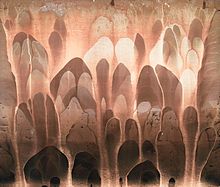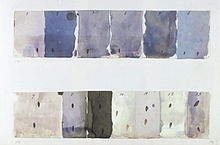- Chemigram
-
Chemigram is a method of creating art with light sensitive paper.
Contents
Process
The chemigram procedure is at the intersection of both painting and photography, and lies within the general domain of experimentation in the visual arts. It requires the use of materials from silver-halide based photography (light-sensitive paper, developer and fixer), but even so it is not a photograph. Like the photogram, the chemigram is made without a camera, yet it is created in full light instead of in the darkness of the darkroom. For this reason it is not – literally – ‘light that writes’ (‘photo graphein’ in the Greek) but ‘chemistry that writes’. Hence the name: chemigram.
Chemigrams can be made solely with photo paper, developer and fixer, with results that will somewhat resemble watercolor. The possibilities can be multiplied by using materials from painting (varnish, wax, oil),[1] These kinds of experiments are akin to those of Paul Klee, Max Ernst, and Antoni Tàpies.
Timeline
Hippolyte Bayard (1801–1887) could be regarded as the first to obtain a chemigram-like image, during sensitization tests he conducted in 1839. In the 1930s and 1940s the German Edmund Kesting and the Frenchman Maurice Tabard produced pictures by painting with developer and fixer on photographic paper. It is the Belgian artist Pierre Cordier (b.1933), however, who has been most responsible for developing and exploring this technique.[2] From his early days, in 1956, he was one of its rare practitioners, and contributed to its development by expanding its technical and esthetic possibilities. He adopted the name ‘chimigramme’ in French in 1958 (‘chemigram’ in English and in Dutch, ‘Chemigramm’ in German, ‘chimigramma’ in Italian, ‘quimigrama’ in Spanish and Portuguese), the most widely accepted designation today. The technique has gradually spread throughout the world and includes numerous practitioners.
Bibliography
- Burguet (Frantz-André), April 1963. « Dialogue avec les faiseurs d’images », L’Arc, 21, Aix-en-Provence.
- Cartier-Bresson (Anne) (dir.), 2008. Le Vocabulaire technique de la photographie, Paris, Marval.
- Cordier (Pierre), 1982. « Chemigram, A new approach to Lensless Photography », in: Leonardo, 4, Oxford, 262-268.
- Jäger (Gottfried), 2005. Concrete Photography, Bielefeld, Kerber Verlag.
- Poivert (Michel) & Gunther (André) (dir.), 2007. L’art de la photographie, Citadelles & Mazenod, 496-501.
- Pollack (Peter), 1969. The Picture History of Photography, New York, Abrams.
References
- ^ Cordier, Pierre (Autumn 1982). "Chemigram: A new approach to lensless photography". Leonardo (The MIT Press) 15 (4): 262–268. JSTOR 1574733.
- ^ Pierre Cordier
External links
Categories:- Photographic techniques
Wikimedia Foundation. 2010.


